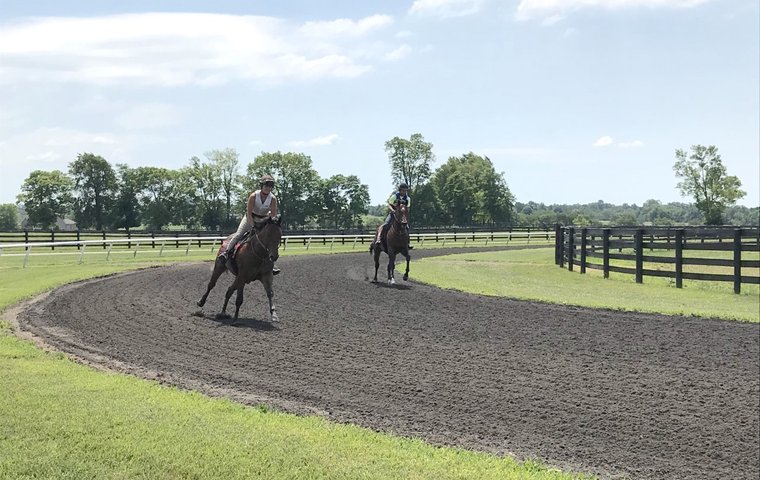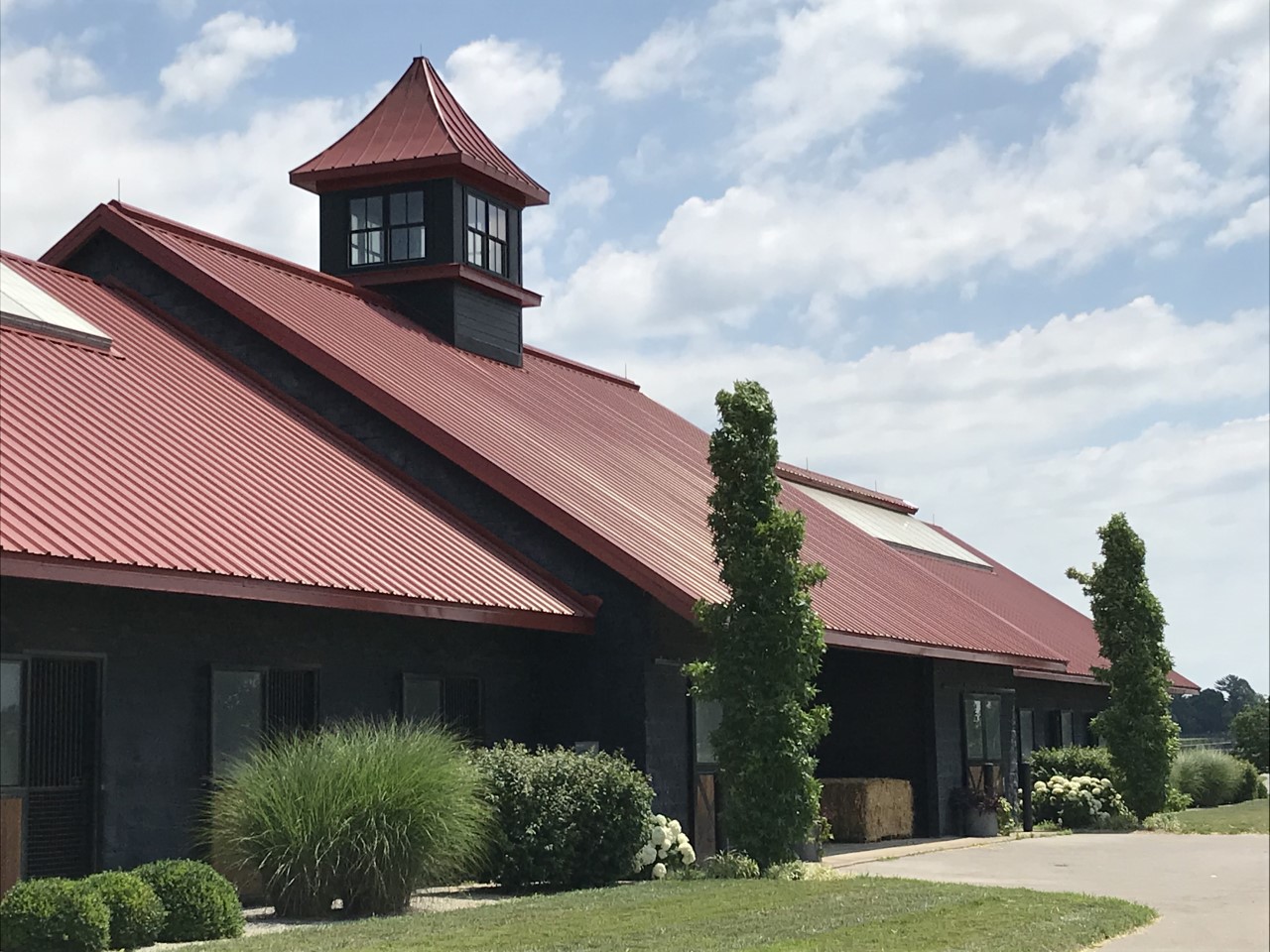
Often, they watch a just-born foal trembling unsteadily as it stands for the first time. They watch it interact with other babies in a paddock and how it moves at an early age. They know the intelligence, quirks, and temperament. They work with the horse in breaking and then watch early gallops leading into breezes over distances.
They are farm trainers of Thoroughbreds, and while racetrack trainers prepare a horse for a race, farm trainers prepare a horse for a career.
The purses, the fame, the winning-circle photos and press interviews for racehorse trainers are not part of life for their farm counterparts, and those things are temporary and fleeting. What a farm trainer has, however, are memories of horses over the hours, days, and months of growth and development. If racetrack trainers have a ‘working relationship’ with horses as they seek ‘ROI’ — Return on Investment - for owners and themselves, farm trainers have something entirely different.
The key, perhaps, in understanding the relationship is in the word ‘farm’. Farm trainers raise a crop, in the strictest sense, but a living, breathing one. Therein lies a huge difference.
 It should be no surprise the regard Richard Budge (pictured), former farm trainer at WinStar Farm in Versailles, Kentucky, for 17 years, has for horses. “They’re like your children,” he said. “They load into vans at 2-years-old and your heart breaks. It’s very emotional.”
It should be no surprise the regard Richard Budge (pictured), former farm trainer at WinStar Farm in Versailles, Kentucky, for 17 years, has for horses. “They’re like your children,” he said. “They load into vans at 2-years-old and your heart breaks. It’s very emotional.”
Budge left WinStar for Margaux Farm in nearby Midway, Kentucky, to serve as general manager where he now “trains the trainer” - 30-year-old Irishman Dermot Littlefield.
“We’re not in this business just to try and make money. We’re in it because we love horses,” said Budge, a native of Bath, England, whose career spans the proverbial ‘pay grades’ of racing - stable lad/groom, exercise rider, assistant trainer, and trainer.
He had thoughts of a jockey career in flat racing outweighed, literally, by growth. And, perhaps modestly, he admitted he was not good enough to carry more weight over jumps.
His career, however, has taken him much farther than around a racecourse. From England, racing has taken him to France, the U.S., Brazil, and then back to the U.S., where he has been since 1998.
The late David Nicholson, a renowned jumps trainer in England, gave Budge sage advice for his career. “He told me to just do a little bit of everything - stallions, yearlings, sales preparation, steeplechase and flat racing, and to travel.” Nicholson, surely, had no idea just how much Budge would take the last bit of advice to heart.
He began working for the late Toby Balding, one of just six trainers to have won the ‘big three’ of British jump races since the Second World War — the Grand National, the Cheltenham Gold Cup and the Champion Hurdle. Moving to France and Chantilly, he came under the tutelage of a then little-known English trainer and fellow British expatriate just starting out, Jonathan Pease. An American racing fixture, the late Cot Campbell, came next into Budge’s life, inviting him to the U.S., which led to 12 years as an assistant to the late trainer Steve DiMauro.
Visa issues dictated one more move for Budge - to Brazil - and training vastly different from anything he had seen before. “They x-rayed the knees to make sure they were closed, then broke them late, and they trained with no saddles. That was totally different for me. The thought process in Brazil is the horses were more relaxed ridden bareback with just one pad.”
The lesson learned in his travels, particularly in Brazil, was an important one. “There’s not just one way to train racehorses.”
Keen eye
Budge left Brazil for the U.S. and racetrack training on the Texas circuit in 1998. He departed the racetrack for WinStar in 2002 and moved to Margaux in January of 2019.
Experience is a great teacher, and Budge, obviously, has it in spades. He has, over years and decades, trained hundreds, if not thousands, of horses with training regimens as disparate as summer heat in Rio and winter cold at Aqueduct in New York. Perhaps inevitably, he has developed a keen eye for a horse.
“The top horses stand out from day one. They just exude something different,” he said. “The first time you look at them, there’s just class. They float. The way they move over the ground, it’s too easy.”
He smiled, though, reflecting on the surprises that have been part of his experience. “I remember one that went to Todd Pletcher. He trained and trained and trained, and he never really showed much. We shipped him out and he wound up a multiple stakes winner. He was a solid horse.”

And then there was a 2-year-old, Budge remembers, who could breeze four furlongs in 47 seconds under wraps. “I said, ‘This is a stakes horse.’ And he never broke his maiden.
“The good ones are the easy ones,” he added. “The challenging ones are maybe not quite as talented, and that’s where a trainer has to really think everything through. I know myself, unfortunately, not every racehorse is a racehorse.
“Being a farm trainer, the job is to get the most out of the horse that we can … to have them in the best condition when they ship out and also to guide the client and racetrack trainer to what level of talent that he or she is.
“Some horses change. Two-year-olds really change. One horse that you didn’t like in March, you may love in July.”
Guidance to racetrack trainers as well as horse owners extends, perhaps surprisingly, to where a horse is shipped for the right level of competition. “You determine if it’s a Belmont, Saratoga or Churchill kind of horse or maybe he or she needs a little less of a racetrack. The key is honesty in communication with the owner and trainer.”
Time with Justify and others
Budge and others at Margaux never lose touch with their former horses at the racetrack. “We follow every breeze and we get worried if a horse hasn’t breezed. We take a lot of pride in their success.”
Most notable among the multitude of Budge’s ‘children’ was Triple Crown winner Justify. To answer the immediate question that comes to everyone’s mind, while he saw a horse with incredible conformation and an extraordinary walk that foretold running ability, he did not foresee a Triple Crown winner. Other top performers include Songbird, Honor Code, Super Saver and Uncle Mo.
Paradoxically, the best ‘school’ for a farm trainer is not on the farm but on the racetrack. Budge said his greatest preparation for farm training was 12 years as an assistant to DiMauro, where he managed a 20-horse string at Meadowlands in New Jersey, thrusting him into a role as “pretty much the trainer”.
Back last winter, Budge had Littlefield, from County Wicklow, south of Dublin, saddle horses from Margaux for races at Turfway Park, 75 miles or so north of Midway. “We raced a few just for the owners, Jim and Susan Hill,” said Budge. The objective was to prepare horses for the spring and fall meets at Keeneland and, important as well, provide Littlefield racetrack experience. “That was to learn what level of fitness the horses needed to compete. That’s a whole learning process for a farm trainer.”
Ironically, Margaux Farm is completion of a full circle in a certain sense for Budge as the farm features a European-style layout for workouts. Horses work out on a three-quarter-mile straight track over a synthetic surface.
“You can gallop a good mile and a half on the straight by going up and then back down with just a slight incline, so basically the breezing will be going up the hill.” While not as severe as at Newmarket in England, according to Budge, “the straight track really helps soundness. They’re not turning left day after day like at a racetrack.”
There is also the opportunity for more paddock turnout, which not all training centers have. “You can freshen them up, keeping them turned out in a paddock,” he said, another similarity to British racing yards.
The most obvious differences in farm training for Budge is “six days a week rather than seven”, and mornings that don’t begin at 5 a.m. as they do on the racetrack. The biggest one, however, is the flexibility in farm training as opposed to the racetrack, where hewing to a schedule of race dates and entries is everything.
Fondest memory
Littlefield, with racetrack experience barely a full year behind him, expanded on the difference. “Sometimes when you’re training on the farm, you have an end goal of a month to ship a horse out. And if it doesn’t ship on a Tuesday, it might go on a Wednesday, and that’s okay.
“Racing makes you home in on everything and get everything very precise as you build up to race day. For sure, when you’re putting on the saddle and everything you feel the pressure a little bit more.”
For Budge, his fondest memory of the racetrack goes back, not surprisingly, to the last horse he saddled in a racetrack paddock, but not for reasons one would expect. An overweight horse at Lone Star Park that Budge swears had to “squirm” his way out of the gate was one bookend of a story that brings a smile to his face.
After considerable conditioning, Budge said the horse ran in the snow at Turfway in northern Kentucky on a track covered by it and … (drum roll, please) won by eight lengths.
“I knew that was the last horse training as a public trainer and I had to load him on the van, and he had to ship to the next trainer. That was heartbreaking.”
From foal birth to first-place, the common thread is the most important one: Heart for a horse.


